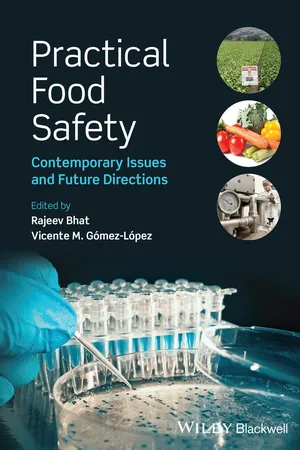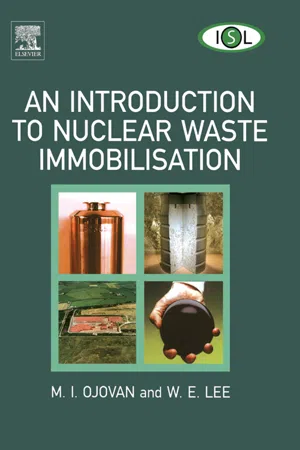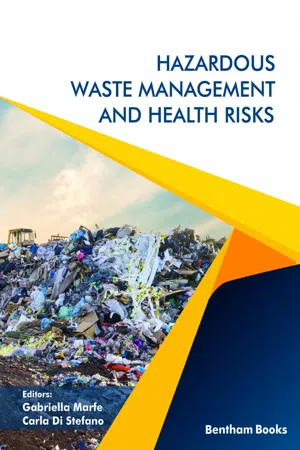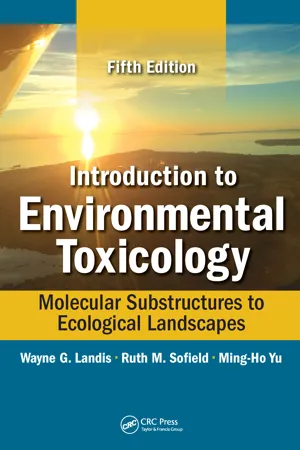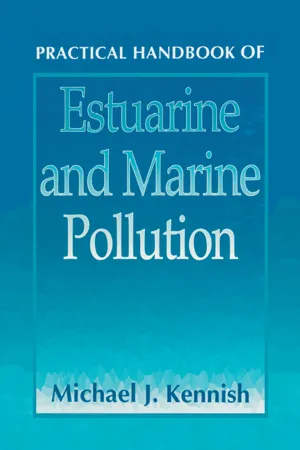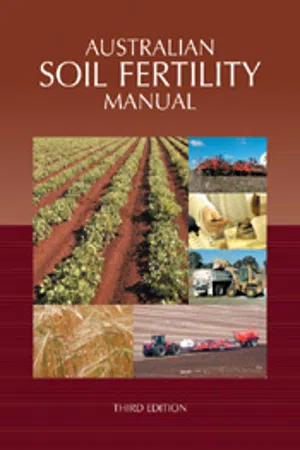Heavy Metals
Heavy metals are metallic elements with high atomic weights and densities, such as lead, mercury, and cadmium. They are naturally occurring in the Earth's crust but can also be released into the environment through human activities like mining and industrial processes. Heavy metals can accumulate in soil and water, posing risks to ecosystems and human health.
8 Key excerpts on "Heavy Metals"
- eBook - ePub
Practical Food Safety
Contemporary Issues and Future Directions
- Rajeev Bhat, Vicente M. Gómez-López, Rajeev Bhat, Vicente M. Gomez-Lopez(Authors)
- 2014(Publication Date)
- Wiley-Blackwell(Publisher)
...12 Heavy Metals of Special Concern to Human Health and Environment Sameeh A. Mansour Environmental Toxicology Research Unit (ETRU), Pesticide Chemistry Department, National Research Centre, Cairo, Egypt Summary Heavy Metals are natural components of the Earth’s crust and their excessive release in the environment is mainly due to human anthropogenic activities. These Heavy Metals cannot be degraded or destroyed and can easily enter the human body along the foods chains (via food, water, or air). Moreover, they have a tendency to accumulate in the human body, causing detrimental health effects even at minute concentrations. In this respect, Heavy Metals of special concern to human health and environment will be addressed. 12.1 Introduction The main threats to human health and environment from Heavy Metals are mainly associated with exposure to certain metals such as mercury, cadmium, lead, chromium, and arsenic. These metals have been extensively studied and their effects on human health regularly reviewed by international bodies such as the World Health Organization (WHO). Humans are responsible for the release of large quantities of metals, including arsenic (As), cadmium (Cd), chromium (Cr), lead (Pb), and mercury (Hg) into the environment (Nriagu and Pacyna, 1988). Once released, these metals are cycled between environmental media. Soils may become highly contaminated due to both direct land disposal of wastes and fallout from atmospheric emissions. Heavy Metals in particular have long residence times in soils because of sorption to soil particles (Fetter, 1992), which increases the potential risks for human exposure and adverse human health effects at both the cellular level (Delmas et al., 2000; Fulladosa et al., 2002) as well as higher levels (Stewart et al., 2003). Metal exposure to humans has been widely studied. Different populations show disproportionate susceptibilities to metals (Vahter et al., 2002)...
- eBook - ePub
- Rattan Lal, Rattan Lal(Authors)
- 2020(Publication Date)
- CRC Press(Publisher)
...Soil is the primary reservoir of Heavy Metals in the atmosphere, hydrosphere, and biota, and thus plays a fundamental role in the overall metal cycle in nature (Cao et al., 2010). Metals are added to soils through anthropogenic activities, such as mining, smelting, industry, agriculture, and burning fossil fuels. In recent years, disposal of electronic waste materials containing Heavy Metals has also contributed to the burden of heavy metal contamination in soils. Heavy metal contamination of soil caused by geogenic materials is also a problem at many places worldwide. Some soils have naturally high levels of Heavy Metals and, in some cases, plant species, which can take up and store large amounts of Heavy Metals, have evolved in these locations. A good example is soils developed on alum shale parent materials in southeastern part of Norway, where these soils contain many fold higher concentrations of Heavy Metals than the other agricultural soils (Mellum et al., 1998), and food crops (cereals, potato, and vegetables) showed concentrations of cadmium many fold higher than the maximum allowable concentration by World Health Organization (WHO) for human consumption (Singh et al., 1995; Mellum et al., 1998). Heavy Metals in soil do not only pose environmental threats but can also create hazards to human health. Several of these elements are necessary for human health, and are beneficial when taken into the body in the form of foods or as supplements at appropriate, low levels because they are quintessential to maintain many physiological and biochemical functions in living organisms at very low concentrations...
- eBook - ePub
- Michael I. Ojovan, William E Lee, William E. Lee(Authors)
- 2010(Publication Date)
- Elsevier Science(Publisher)
...Chapter 4 Heavy Metals Publisher Summary This chapter highlights comparison of problems arising from heavy metal elements to those associated with radionuclides. Unlike radioactive elements, the toxicity of stable elements does not diminish with time; they can only change form. Certain forms of some metals can be quite toxic even in relatively small amounts. Heavy Metals in consumer goods and industrial processes enter the environment from burning or burial of waste in landfill sites. These increase the flux of metals that can be transported by wind and water and thus find their way into plants, animals and finally to humans. The term heavy metal is used loosely but generally refers to any metallic chemical element that has a relatively high density and is toxic or poisonous at low concentrations, and includes Hg, Cd, As, Cr, Tl and Pb. Heavy Metals, such as Pb, Cd, Hg, As, Se and Zn belong to the so-called first class of hazard. Human activity has drastically changed the biogeochemical cycles and balance of some Heavy Metals in the environment. The most important processes for such biotransformations are the formation of inert complexes and the cleaving or building of bonds with carbon, for example, methylation and de-methylation. The creation of carbon bonds via methylation reduces the toxicity of As and Se because it allows an animal to excrete the metal. In contrast, methylation of Hg increases its toxicity because methyl mercury is more toxic than inorganic forms of Hg. Heavy Metals tend to accumulate in certain storage compartments in organisms. Cd accumulates preferentially in the kidneys, Hg in the liver and Pb in the skeleton. The accumulation can continue throughout the organism’s life and is the major cause of chronic toxicity...
- eBook - ePub
- Gabriella Marfe, Carla Di Stefano(Authors)
- 2020(Publication Date)
- Bentham Science Publishers(Publisher)
...Many investigations have been carried to study the variation in soil properties because of heavy metal pollution. The presence of heavy metal affects the land use pattern and crop quality [ 11 - 14 ]. Efforts are being taken to evaluate and quantify the effect of heavy metal on soil properties [ 15 - 17 ]. Predictive and statistical tools are useful in studying soil pollution and predicting the effect of various pollutants on the environment [ 17 - 20 ]. Heavy Metals have the tendency to accumulate in biological systems, given that they are essential for biological activities. Adverse effects caused by some Heavy Metals make them important candidate for investigation for their removal from the environment [ 21 - 24 ]. Heavy Metals like cadmium, nickel, lead, copper, and chromium are used for various applications. Various physical, chemical, physico-chemical, and biological treatment methods can be used for the treatment of wastewater for heavy metal removal [ 25 - 28 ]. Many of these methods have limitations in terms of cost-effectiveness, efficiency, environmental safety, and solid waste generation [ 29, 30 ]. To explore an efficient, economical, and sustainable alternative for heavy metal removal, many investigators have investigated adsorbents derived from various waste materials, coagulants, flocculating agents, membranes, and ion exchange resins. This book chapter sheds light on studies on heavy metal sources, their effects on human health, and control methods. Effects of Heavy Metals on plants, animals, and aquatic habitats are also discussed as these are consumed by human beings as food and are sources of Heavy Metals in the human body. Sources of Heavy Metals The sources of Heavy Metals are diverse in nature [ 31 ]. Many human activities such as smelting, use of insecticides, and burning of fossil fuel lead to severe environmental pollution. Many gases are emitted into the atmosphere as a result of the oxidation of metals present in the fuels...
- eBook - ePub
Introduction to Environmental Toxicology
Molecular Substructures to Ecological Landscapes, Fifth Edition
- Wayne Landis, Ruth Sofield, Ming-Ho Yu(Authors)
- 2017(Publication Date)
- CRC Press(Publisher)
...CHAPTER 10 Metals 10.1 INTRODUCTION Pollution caused by metals is a worldwide phenomenon. Among the many metals, lead (Pb), mercury (Hg), cadmium (Cd), arsenic (As), chromium (Cr), zinc (Zn), and copper (Cu) are of most concern for toxicity, although the last three metals are also essential nutrients in animal and human nutrition. These metals are widely used in industry, particularly in metal working or metal plating, and in such products as batteries and electronics. They are also used in the production of jewelry, paint pigments, pottery glazes, inks, dyes, rubber, plastics, pesticides, and even in medicines. These metals are often referred to as Heavy Metals, although this terminology is imprecise, misleading, and a scientific consensus does not exist as to which metallic elements are Heavy Metals (Duffus 2002). Another term that is often used without scientific consensus is metalloid, which often includes elements such as arsenic that have intermediate properties between metals and solid nonmetals. From a toxicological perspective, chemical speciation is as important to consider as the metal; as discussed in Chapter 5, a metal in the elemental form will have a different toxicity than the same metal complexed to an inorganic or organic ligand. In this chapter, we will refer to the elements of interest as metals and important speciation considerations will be addressed. Metals, such as those listed earlier, are relatively toxic because, as ions or in compound forms, they are soluble in water and may be readily absorbed into living organisms. After absorption, these metals can bind to vital cellular components such as structural proteins, enzymes, and nucleic acids, and interfere with their functioning. In humans, some of these metals, even in small amounts, can cause severe physiological and health effects...
- Michael J. Kennish(Author)
- 2017(Publication Date)
- CRC Press(Publisher)
...6 Heavy Metals INTRODUCTION Among the most intensely studied contaminants in estuarine and marine environments are Heavy Metals, a group of elements with atomic weights ranging from 63.546 to 200.590 and characterized by similar electronic distribution in the external shell (e.g., copper, zinc, cadmium, zinc). 1 Because of their toxicity to estuarine and marine organisms above a threshold availability and their persistence in the environment, Heavy Metals pose potentially hazardous conditions. They may be subdivided into two categories: (1) transitional metals (e.g., cobalt, copper, iron, manganese) which are essential to metabolism at low concentrations but may be toxic at high concentrations, and (2) metalloids (e.g., arsenic, cadmium, lead, mercury, selenium, tin) which generally are not required for metabolic function but are toxic at low concentrationss. An approximate order of decreasing toxicity of common Heavy Metals in aquatic organisms is as follows: mercury, cadmium, copper, zinc, nickel, lead, chromium, aluminum, and cobalt. 2 At elevated levels, Heavy Metals act as enzyme inhibitors in organisms; however, the toxicity of a given metal can vary significantly from one species to another. The accumulation of Heavy Metals by marine organisms is a function of many factors, such as temperature, salinity, diet, spawning, and the ability of the organism to regulate metal concentrations in the body. 3 SOURCES Heavy Metals enter the sea via several major routes, most notably riverine influx, atmospheric deposition, and anthropogenic activities. A large quantity of metals in river water originates from the weathering of rocks and leaching of soils and, hence, depends in part on the occurrence of metals and ore-bearing deposits in the drainage area. However, the metal burden is often augmented by anthropogenic sources where rivers flow through urban or industrialized centers. The atmosphere represents the principal route of entry of certain metals to the sea...
- eBook - ePub
- FIFA, FIFA(Authors)
- 2006(Publication Date)
- CSIRO PUBLISHING(Publisher)
...11 Heavy Metals in fertilizers and agriculture The Heavy Metals are a group of metals so described because they have a specific gravity of five or higher, i.e. they are five or more times heavier than water. Those that are of importance in agriculture are copper (Cu), zinc (Zn), cadmium (Cd), lead (Pb), mercury (Hg), molybdenum (Mo) and nickel (Ni), although not all are universally regarded as Heavy Metals. As discussed earlier in this manual, copper, molybdenum and zinc are essential nutrient elements. The others, which are not essential elements for plant growth, may be present in some foods, and if consumed in sufficient quantity over a long period of time, can be detrimental to human health. Heavy Metals in food can be derived from various sources, including amounts taken up directly from the soil by plants, or from soil contamination of harvested produce. Animals can also accumulate Heavy Metals from plants or by direct ingestion of soil while grazing, and these metals may affect animal health as well as human health. Heavy Metals occur naturally in soils. They are also present in small amounts as impurities in some fertilizers, which may add to background levels in the soil. Cadmium is the heavy metal that is of most concern in agriculture, particularly through its presence in phosphorus fertilizers and some soil conditioners. Effects on human health Toxicity in animals and humans may be either acute (due to sudden intake at very high amounts) or chronic (intake at lower rates over a long period of time). Acute poisoning is usually the result of accident or mishap, while chronic poisoning is generally due to occupational exposure, inhalation or ingestion in food. Food Standards Australia New Zealand (FSANZ) established acceptable limits for Heavy Metals in foodstuffs, referred to as maximum levels (MLs). These are assessed against provisional tolerable weekly intakes (PTWIs) for the combined intake from all sources. PTWIs are set internationally, i.e...
- eBook - ePub
Soils and Groundwater Pollution and Remediation
Asia, Africa, and Oceania
- P. M. Huang, I.K. Iskandar(Authors)
- 2020(Publication Date)
- CRC Press(Publisher)
...Although it is only distinction in terms of operation, it helps in acquisition of certain useful knowledge concerning the chemical behaviors of the heavy metal elements originally existing in the soil or coming externally from other sources, and the effects of different soil solid components on adsorption and enrichment of heavy metal elements in the soil, which can be used as a basis for controlling heavy metal pollution of the soil. Human activities, such as mining, can significantly change the concentrations of water-soluble heavy metal elements in the soil. A comparison study revealed that the proportions of the concentrations of the water-soluble Zn, Cu, Co, Mn, Cr, and Pb to their totals in the soil polluted from copper mining are 372, 8392, 850, 576, 73, 24, and 12 times higher, respectively, than those in the unpolluted soil in the neighboring farmland. Some of the industrial and mining areas of China are rather seriously polluted by Heavy Metals. For instance, in Jiangxi Province, the soils in the neighborhood of its major metal smelting plants and mines produced fodder that was significantly contaminated, particularly by Cu, Mo, and Cd. In the neighborhood of tungsten minings, Mo and Cd are the major pollutants, and the serious disproportion between Cu and Mo in the fodder produced leads to extensive incidence of Mo and Cd poisoning syndrome on farm cattle. In the farmland in the vicinity of Cu minings and smelteries, the soils may contain as much as 3766 mg Cu/kg and the fodder produced thereupon as much as 1572 mg Cu/kg. The farmland soil there contains 29.5 mg Cd/kg and the fodder produced thereupon, 16.1 mg Cd/kg. In some industrial and mining areas of Guizhou, the soils are severely polluted. And the soil in Zhangshi Irrigation Area of Liaoning is also rather seriously polluted by Cd-containing sewage. Management of heavy metal pollution of the soil has been a major concern of the people...
